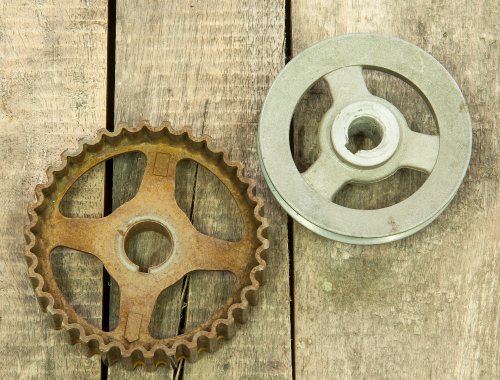
Pulleys and Gears: Mechanics in Motion
Introduction
Pulleys and gears are fundamental mechanical components that have played a significant role in human history. These ingenious devices, rooted in the principles of physics and engineering, are used in countless applications, from simple machines to complex industrial systems. In this 1500-word article, we will delve into the world of pulleys and gears, exploring their definitions, functions, types, and real-world applications.
Section 1: Understanding Pulleys
1.1 What Is a Pulley?
- A pulley is a simple machine consisting of a wheel or drum mounted on an axle, with a groove or channel around its circumference. It is used to change the direction of a force and transmit motion.
1.2 How Do Pulleys Work?
- Pulleys work on the principle of mechanical advantage. They can be fixed, movable, or compound, and they allow us to lift heavy loads with less effort by redirecting the force applied.
1.3 Types of Pulleys
- Explore the different types of pulleys, including fixed pulleys, movable pulleys, and compound pulleys. Learn how each type offers specific advantages in various applications.
1.4 Applications of Pulleys
- Discover the wide range of applications for pulleys, from lifting and lowering objects in construction and manufacturing to the mechanics of elevators and cranes.
Section 2: Exploring Gears
2.1 What Are Gears?
- Gears are mechanical devices consisting of toothed wheels that mesh together. They transmit motion and mechanical energy from one part of a machine to another.
2.2 How Do Gears Work?
- Delve into the mechanics of gears, understanding how their teeth engage and disengage to provide speed reduction, speed increase, or torque multiplication.
2.3 Types of Gears
- Explore the diverse types of gears, including spur gears, helical gears, bevel gears, and worm gears, each suited for specific tasks and applications.
2.4 Gear Ratios
- Learn about gear ratios and their significance in determining the relationship between input and output speeds and torques in gear systems.
Section 3: Real-World Applications
3.1 Pulleys in Daily Life
- Examine how pulleys are used in everyday life, from the cords on window blinds to the belts in car engines. Understand how they simplify tasks and make work more efficient.
3.2 Gears in Technology
- Explore the role of gears in modern technology, including their use in automobiles, bicycles, and industrial machinery. Learn how they enable precise control and efficient power transmission.
3.3 Pulleys and Gears in Manufacturing
- Understand the critical role pulleys and gears play in manufacturing processes, such as assembly lines, conveyor systems, and robotic automation.
3.4 Architectural Applications
- Discover how pulleys and gears are used in architectural applications, such as elevators, escalators, and drawbridges, to provide vertical transportation and structural movement.
Section 4: Advancements and Innovations
4.1 High-Tech Gearing
- Explore cutting-edge developments in gear technology, including the use of advanced materials, lubrication systems, and computer-aided design for optimized gear performance.
4.2 Smart Pulley Systems
- Learn about the integration of sensors, automation, and data analytics in modern pulley systems, enhancing efficiency and safety in various industries.
4.3 Sustainable Engineering
- Discover how sustainable engineering practices are incorporating pulleys and gears in renewable energy systems, reducing environmental impact and promoting energy efficiency.
Section 5: Educational and DIY Projects
5.1 Learning with Pulleys and Gears
- Engage in educational activities and DIY projects that demonstrate the principles of pulleys and gears, making learning about mechanics fun and hands-on.
5.2 Building Simple Machines
- Step-by-step instructions for creating simple machines using pulleys and gears. These projects are suitable for students, educators, and enthusiasts alike.
Conclusion
Pulleys and gears, these seemingly unassuming mechanical components, are the unsung heroes behind many of the devices and systems that shape our daily lives. From the pulley systems that lift heavy loads with ease to the intricate gear assemblies that power our machines, understanding the principles and applications of these mechanisms is key to appreciating the world of mechanics. As technology advances and innovation continues, pulleys and gears will undoubtedly remain essential elements in our ever-evolving mechanical landscape.
Frequently Asked Questions (FAQ) About Pulleys and Gears
1. What is the primary function of a pulley?
- The primary function of a pulley is to change the direction of a force and transmit motion. Pulleys are often used to lift or lower objects with less effort.
2. How do pulleys work?
- Pulleys work by using a wheel or drum with a groove to guide a rope, cable, or belt. As the rope is pulled, the pulley rotates, allowing for the transfer of force and motion.
3. What are the main types of pulleys?
- There are three main types of pulleys: fixed pulleys, movable pulleys, and compound pulleys. Fixed pulleys change the direction of force, movable pulleys provide a mechanical advantage, and compound pulleys combine fixed and movable pulleys for increased lifting power.
4. What are gears, and what do they do?
- Gears are toothed wheels that mesh together to transmit motion and mechanical energy from one part of a machine to another. They are used to change the speed, direction, or torque of rotational motion.
5. How do gears work?
- Gears work by the interaction of their toothed surfaces. When one gear turns, it engages with the teeth of another gear, causing it to rotate. This transfer of motion allows for speed reduction, speed increase, or torque multiplication.
6. What are some common types of gears?
- Common types of gears include spur gears, helical gears, bevel gears, and worm gears. Each type is designed for specific tasks and applications.
7. What is a gear ratio, and why is it important?
- A gear ratio is the relationship between the number of teeth on two gears. It determines how much one gear will rotate concerning the other and is crucial for controlling speed and torque in gear systems.
8. Where can I find pulleys and gears in everyday life?
- You can find pulleys and gears in numerous everyday applications, including vehicles (cars, bicycles), household appliances (washing machines, blenders), manufacturing equipment (conveyor belts, assembly lines), and architectural structures (elevators, drawbridges).
9. How are pulleys and gears used in advanced technology?
- In advanced technology, pulleys and gears are used in precision instruments, robotics, aerospace, and automotive industries to provide precise control and efficient power transmission. They are often integrated into complex machinery and systems.
10. Are there educational resources and DIY projects for learning about pulleys and gears?
- Yes, there are many educational resources, books, and online tutorials that explain the principles of pulleys and gears. Additionally, there are DIY projects and kits available that allow students and enthusiasts to build and experiment with simple machines incorporating these mechanisms.
Pulleys and gears are essential components in the world of mechanics, and understanding their functions and applications can deepen your appreciation for the role they play in our daily lives and technological advancements.












Leave a Reply